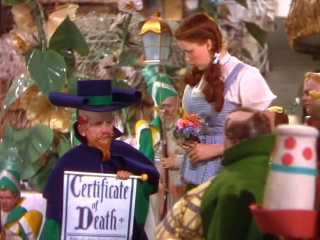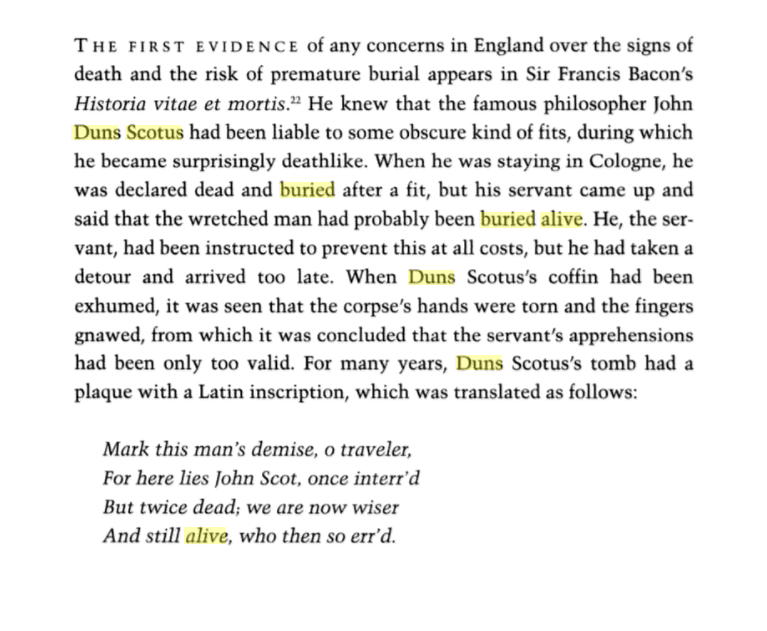I think it’s safe to say that those who lived during the Victorian era had an obsession with death. They crafted small portraits made from the hair of deceased family members that could be placed in brooches and worn, wore lachrymatory bottles (often mistaken for perfume bottles) on chains around their necks in order to catch the tears they wept for a departed loved one, and erected lavish monuments at grave sites. They even purchased new sets of mourning clothes each time someone passed on because keeping such clothing afterward and reusing it was considered bad luck. In fact, stores existed that catered only to those in mourning and sold every item an individual might need to properly mourn a loss. Mourning times ranged from four weeks (first cousins) to two whole years (for a spouse.) We wear black (or dark) clothing to funerals now, so that’s not too terribly odd, but we’ve since moved away from the regular practice of purchasing a special coffin for grandma, fully equipped with a bell, feeding/breathing tube, and spare set of crypt keys, just in case she was mistaken for dead.
Welcome to the wonderous (and often crazy) world of safety coffins.
Taphophobia, the fear of being buried alive, was quite common in the Victorian era, mainly because it was often difficult for doctors at the time to say for sure whether or not someone was sincerely dead. I’m currently flashing back to the scene in The Wizard of Oz where the Munchkin Coroner proclaims the Wicked Witch, “Most sincerely dead.”

On a completely unrelated note, I visited the National Musem of Funeral History in Houston, TX in March of last year and saw the costume worn by Meinhardt Raabe in the film. Anyway, I digress…
Stop Blowing Smoke…
Bodies would often be kept in Waiting Mortuaries or “Apparent Dead Houses” (as they were called in the Netherlands) for a period of time prior to being buried. The bodies in these mortuaries were cared for by a staff of nurses and were not buried until they showed signs of putrification. Flowers were placed by each bedside (to mask the odor or decay) and mirrors or feathers were held under the nose or by the mouths of the deceased in order to check for breath. In Europe, tobacco smoke enemas were often employed. Administered using a bellows, (they were originally done using a pipette and the smoke was blown into the rectum from the mouth of whoever was doing the check) the sensation of the smoke supposedly would wake those falsely proclaimed deceased. There were cases in which people did actually wake up. Of course, these cases then served as proof that the practice was viable. Of course, probes and needles were also used to poke and prod the body. Likely to give the poor bastard stuck with the smoke-blowing job a break. That’s a shitty end to the practice of drawing straws…excuse the pun.
Saved By the Bell
The first safety coffin was designed by Duke Ferdinand of Brunswick around 1790. His model included an air/feeding tube, a window to allow light, and a spare set of keys for the coffin itself and the tomb in which it was housed. By the 19th century, the Germans had created a whole line of safety coffins (around thirty or so) that included elaborate bell and pulley systems. Unfortunately, the human body tends to bloat when decomposing, causing the corpse to shift. Using a bell to detect accidental death is about as realistic as Dustin Diamond resurrecting his career at this point, but many mortuaries and cemeteries employed the bell as a tool to detect mistaken burial.
A Peek At the Afterlife
If you’ve ever gone wandering through Evergreen Cemetery in Vermont, you might have come across the grave of Dr. Timothy Clark Smith whose “window to the world,” is likely the creepiest physical manifestation of Taphophobia. The “window” is actually more of a tube that has a cap on both ends, allowing visitors to look down the tube and into the face of the sleeping Dr. Smith. At least it used to.
http://www.cultofweird.com/death/timothy-clark-smith-grave/
I’m pretty sure all anyone can see at this point is condensation and darkness, but people claimed to have been able to see Smith’s rotting corpse staring up at them, a hammer and chisel nearby to aid his escape. Of course, when Smith died, he was most definitely dead. Others weren’t so lucky.
In a report that dates back to the fourteenth century, whether entirely truthful or not, it is said that the philosopher John Duns Scotus (1266-1308) was buried alive. Upon exhumation, Scotus was reportedly found outside his coffin with his hands and fingertips torn and bloody.
In Buried Alive: The Terrifying History of Our Most Primal Fear, author Jan Bondeson writes,

According to Wikipedia,
Newspapers have reported cases of exhumed corpses which appear to have been accidentally buried alive. On February 21, 1885, The New York Times gave a disturbing account of such a case. The victim was a man from Buncombe County whose name was given as “Jenkins.” His body was found turned over onto its front inside the coffin, with much of his hair pulled out. Scratch marks were also visible on all sides of the coffin’s interior. His family was reportedly “distressed beyond measure at the criminal carelessness” associated with the case. Another similar story was reported in The Times on January 18, 1886, the victim of this case is described simply as a “girl” named “Collins” from Woodstock, Ontario, Canada. Her body was described as being found with the knees tucked up under the body, and her burial shroud “torn into shreds.””
Live burial may seem like a thing of the past, but even the best doctors can make mistakes. The article continues,
“In 2005, a body bag was delivered to the Matarese Funeral home in Ashland, Massachusetts with a live occupant. Funeral director John Matarese discovered this, called paramedics, and avoided live embalming or premature burial.
In 2014 in Peraia, Thessaloniki, in Macedonia, Greece, the police discovered that a 45-year-old woman was buried alive and died of asphyxia after being declared clinically dead by a private hospital; she was discovered just shortly after being buried by children playing near the cemetery who heard screams from inside the earth and afterwards her family was reported as considering suing the private hospital. In 2015 it was reported that in 2014 again in Peraia, Thessaloniki, in Macedonia, Greece, police investigation concluded that a 49-year-old woman was buried alive after being declared dead due to cancer; her family reported that they could hear her scream from inside the earth at the cemetery shortly after burial and the investigation revealed that she died of heart failure inside the coffin and found out that it was the medicines given to her by her doctors for her cancer that caused her to be declared clinically dead and buried alive.”
What are your thoughts on safety coffins, the Victorian view of death and bereavement, and the practice of housing the dead in Waiting Mortuaries? I’d love to read your comments!
Your Fellow Haunt Head,
Janine
hauntheadscast@gmail.com
Tweet us @hauntheadscast
Binge episodes of Haunt Heads at hauntheads.podbean.com or wherever you listen to podcasts!


